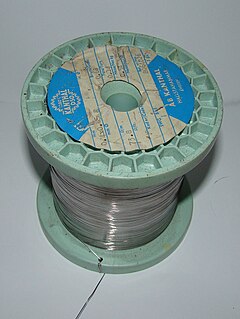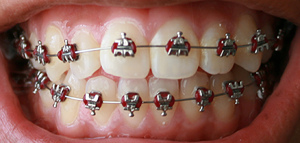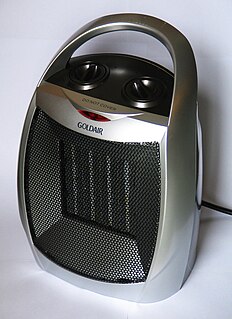
A resistor is a passive two-terminal electrical component that implements electrical resistance as a circuit element. In electronic circuits, resistors are used to reduce current flow, adjust signal levels, to divide voltages, bias active elements, and terminate transmission lines, among other uses. High-power resistors that can dissipate many watts of electrical power as heat, may be used as part of motor controls, in power distribution systems, or as test loads for generators. Fixed resistors have resistances that only change slightly with temperature, time or operating voltage. Variable resistors can be used to adjust circuit elements, or as sensing devices for heat, light, humidity, force, or chemical activity.

A thermistor is a type of resistor whose resistance is strongly dependent on temperature, more so than in standard resistors. The word is a combination of thermal and resistor. Thermistors are widely used as inrush current limiters, temperature sensors, self-resetting overcurrent protectors, and self-regulating heating elements. An operational temperature range of a thermistor is dependent on the probe type and is typically in between −100 °C (−148 °F) and 300 °C (572 °F).

The electrical resistance of an object is a measure of its opposition to the flow of electric current. Its reciprocal quantity is electrical conductance, measuring the ease with which an electric current passes. Electrical resistance shares some conceptual parallels with mechanical friction. The SI unit of electrical resistance is the ohm, while electrical conductance is measured in siemens (S).

Brazing is a metal-joining process in which two or more metal items are joined together by melting and flowing a filler metal into the joint, with the filler metal having a lower melting point than the adjoining metal.
Nichrome is a family of alloys of nickel, chromium, and often iron commonly used as resistance wire, heating elements in things like toasters and space heaters, in some dental restorations (fillings) and in a few other applications.

Fernico describe a family of metal alloys made primarily of iron, nickel and cobalt. The family includes Kovar, FerNiCo I, FerNiCo II, and Dumet. The name is made up of the chemical symbols of its constituent three elements. "Dumet" is a portmanteau of "dual" and "metal," because it is a heterogeneous alloy, usually fabricated in the form of a wire with an alloy core and a copper cladding. These alloys possess the properties of electrical conductivity, minimal oxidation and formation of porous surfaces at working temperatures of glass and thermal coefficients of expansion which match glass closely. These requirements allow the alloys to be used in glass seals, such that the seal does not crack, fracture or leak with changes in temperature.

Joule heating, also known as resistive, resistance, or Ohmic heating, is the process by which the passage of an electric current through a conductor produces heat.
Constantan is a proprietary name for a copper–nickel alloy also known as Eureka, Advance, and Ferry. It usually consists of 55% copper and 45% nickel. Its main feature is the low thermal variation of its resistivity, which is constant over a wide range of temperatures. Other alloys with similarly low temperature coefficients are known, such as manganin.

A heating element converts electrical energy into heat through the process of Joule heating. Electric current through the element encounters resistance, resulting in heating of the element. Unlike the Peltier effect, this process is independent of the direction of current.

Kanthal is the trademark for a family of iron-chromium-aluminium (FeCrAl) alloys used in a wide range of resistance and high-temperature applications. Kanthal FeCrAl alloys consist of mainly iron, chromium (20–30%) and aluminium (4–7.5 %). The first Kanthal FeCrAl alloy was developed by Hans von Kantzow in Hallstahammar, Sweden. The alloys are known for their ability to withstand high temperatures and having intermediate electric resistance. As such, it is frequently used in heating elements. The trademark Kanthal is owned by Sandvik Intellectual Property AB.

An archwire in orthodontics is a wire conforming to the alveolar or dental arch that can be used with dental braces as a source of force in correcting irregularities in the position of the teeth. An archwire can also be used to maintain existing dental positions; in this case it has a retentive purpose.
Glass-coating is a process invented in 1924 by G. F. Taylor and converted into production machine by Ulitovski for producing fine glass-coated metal filaments only a few micrometres in diameter.
Chromel is an alloy made of approximately 90% nickel and 10% chromium by weight that is used to make the positive conductors of ANSI Type E (chromel-constantan) and K (chromel-alumel) thermocouples. It can be used at temperatures up to 1,100 °C (2,010 °F) in oxidizing atmospheres. Chromel is a registered trademark of Concept Alloys, Inc.
Alloy steel is steel that is alloyed with a variety of elements in total amounts between 1.0% and 50% by weight to improve its mechanical properties. Alloy steels are broken down into two groups: low alloy steels and high alloy steels. The difference between the two is disputed. Smith and Hashemi define the difference at 4.0%, while Degarmo, et al., define it at 8.0%. Most commonly, the phrase "alloy steel" refers to low-alloy steels.
Nickel aluminide typically refers to the one of the two most widely used compounds, Ni3Al or NiAl, however is generally any aluminide from the Ni-Al system. These alloys are widely used due to their corrosion resistance, low-density and easy production. Ni3Al is of specific interest as the strengthening γ' phase precipitate in nickel-based superalloys allowing for high temperature strength up to 0.7-0.8 of its melting temperature. Meanwhile, NiAl displays excellent properties such as low-density (lower than that of Ni3Al), good thermal conductivity, oxidation resistance and high melting temperature. These properties, make it ideal for special high temperature applications like coatings on blades in gas turbines and jet engines. However, both these alloys do have the disadvantage of being quite brittle at room temperature while Ni3Al remains brittle at high temperatures as well. Although, it has been shown that Ni3Al can be made ductile when manufactured as a single crystal as opposed to polycrystalline. Another application was demonstrated in 2005, when the most abrasion-resistant material was reportedly created by embedding diamonds in a matrix of nickel aluminide.

Glass-to-metal seals are a very important element of the construction of vacuum tubes, electric discharge tubes, incandescent light bulbs, glass encapsulated semiconductor diodes, reed switches, pressure tight glass windows in metal cases, and metal or ceramic packages of electronic components.
A bridgewire or bridge wire, also known as a hot bridge wire (HBW), is a relatively thin resistance wire used to set off a pyrotechnic composition serving as pyrotechnic initiator. By passing of electric current it is heated to a high temperature that starts the exothermic chemical reaction of the attached composition. After successful firing, the bridgewire melts, resulting in an open circuit.

A ceramic heater as a consumer product is a space heater that generates heat using a heating element of ceramic with a positive temperature coefficient (PTC). Ceramic heaters are usually portable and typically used for heating a room or small office, and are of similar utility to metal-element fan heaters.

A cartridge heater is a tube-shaped, heavy-duty, industrial Joule heating element used in the process heating industry, usually custom manufactured to a specific watt density, based on its intended application. Compact designs are capable of reaching a watt density of up to 50W/cm² while some specialty high temperature designs can reach 100w/cm².










